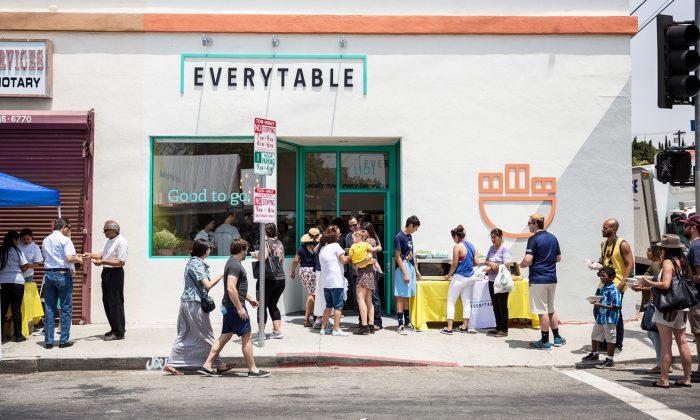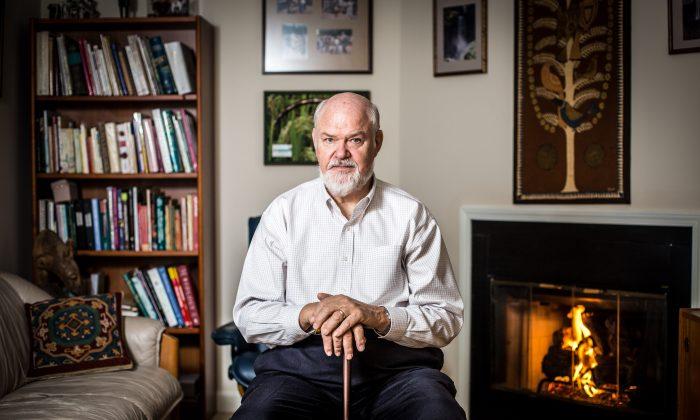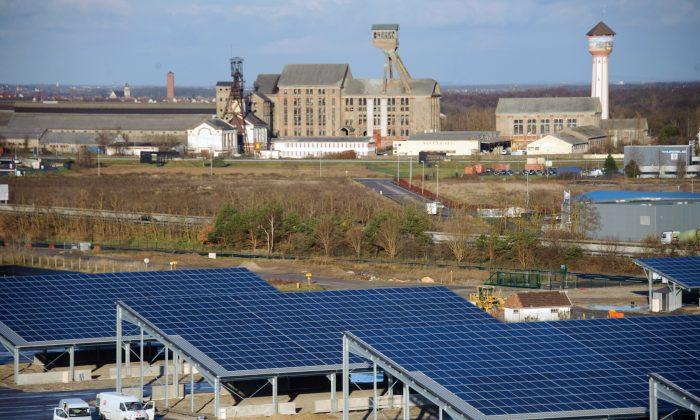A small group of Silicon Valley-funded tech companies is out to disrupt factory livestock farming with plant-meat alternatives that are better for the environment than meat, better for our health, and just as tasty as the real thing.
With a staff of not chefs but mainly chemists, biochemists, and physicists, they are engineering alternatives to meat that look, cook, and impress just like the real thing—blood and all—using only plant ingredients like yellow pea, soybean, spinach, beets, carrots, and the like.
Prominent venture capitalists such as mega-billionaire Li Ka-shing, Sun Microsystems co-founder Vinod Khosla, business magnate and philanthropist Bill Gates, and others have invested $200 million in the two leading companies, Beyond Meat and Impossible Foods, according to Crunchbase.
While Redwood City, California-based Impossible Foods, backed by $183 million, continues to work in its labs on a beef burger and nondairy cheese, Manhattan Beach, California-based Beyond Meat’s grilled chicken strips and homestyle chicken have been on the market for a few years now.
In early 2015, the company released a beef-like Beast Burger, Beyond Beef Crumbles, and Beastly Sliders.

Lux Research, a strategic advisory firm for emerging technologies, predicts that by 2054, meat alternatives will comprise 33 percent of the overall protein market, up from just 2 percent today.
Driving this major shift in our eating habits is a perfect storm of consumer awareness: rising health concerns about consuming meat, the higher cost of meat due to increasing global demand (most notably for animal feed), and environmental concerns about animal agriculture, according to Lux.
Demand from Baby Boomers and Gen X'ers tends to be more health-related, while millennials tend to be motivated more by environmental concerns. Regardless, the market for plant food is now much larger and much more mainstream than before, pushing the boundaries of innovation past the typical vegetarian fare.
And this new group of plant-food explorers still enjoy eating meat. Call them “flexarians.” In fact, these people may even prefer that their meat substitute fool them into believing it’s the real thing.
Influential food writer Mark Bittman as well as Gates have both said they could not tell in a blind taste test the difference between Beyond Meat’s plant-based chicken and real muscle meat.
Food critic Corby Kummer, writing for the MIT Technology Review, said his impression was that Beyond Meat’s products were only getting close to the experience of “debased industrial meat.”
They are likely decades away from achieving the quality of a fine steak, “with the intramuscular marbling fat that bastes every bite,” Kummer wrote. But to be fair, he acknowledges for the company to achieve a product comparable to a Tyson chicken strip is indeed progress.
Gates wrote on his personal blog that the earth cannot support enough animal agriculture to feed the world’s growing population, and companies like Beyond Meat have taken on the challenge of finding alternatives that do not require asking everyone to become vegetarian.
He famously deemed his bite of chicken taco, made with Beyond Meat, no less than “a taste of the future of food.”
A Growing Industry
While the market for plant meat is still nascent today, it is growing at a healthy rate of 8.4 percent annually, according to Allied Market Research, nearly triple the overall growth in the food industry.

Already, a surprising variety of meat alternatives can be found at natural grocers. Meat substitutes made from seitan (a wheat product), and tofu and tempeh (made from fermented soybeans), have been around for decades and are associated with incumbent brands Tofurky, Yves Veggie Cuisine, and Gardein.
Lux researcher Sara Olson says soy’s dominant 95 percent market share is expected to reduce to just 22 percent by 2054 as other meat-alternative options develop.
Some of the newer companies out there now include Sophie’s Kitchen seafood made with the Southeast Asian superfood konjac, jackfruit meat introduced recently by Upton’s Naturals, and a savvy blend of whole foods offered in a wide variety of meaty options by Sweet Earth Foods.
In fact, some vegetarians say they find some of these new fake-meat products somewhat offensive, or they may even feel baffled by claims on the products that appeal to meat-eaters, such as “flame-broiled,” and “quarter-pounder.” That is a little too meaty!
Other vegetarians may find themselves utterly drawn in by the artful packaging and product allure.
Nadia Berenstein, a food historian who is also a vegetarian, called Beyond Meat in a recent telephone interview, “an exquisitely technological and artificial product.”

Engineered Plant Blood
Companies like Beyond Meat are aiming to fully simulate the meat experience—blood, sizzle, and all. The product also needs to provide the same, or better, protein and nutritional value as meat, something the products deliver in spades, plus added nutrition.
Beyond Meat’s Beast Burger advertises antioxidants, iron, calcium, vitamins B6, B12, and D, potassium, DHA and ALA, Omega-3s, and a “nutrient blend, which aids in muscle recovery” (good for people who do sports).
Plant meat is also free of everything unhealthy that is typically associated with meat: cholesterol, trans fats, and saturated fats, as well as the trace amounts of antibiotics and hormones meat may contain.

To make a product like Beyond Meat, a powdered form of extracted plant proteins is mixed with the other ingredients in a high-moisture extruder machine, according to scientists familiar with the process.
With the application of just the right amount of heat, pressure, and agitation, the plant proteins can be coaxed through chemical and physical reactions into a structure and arrangement—a texture—that mimics meat.
Hydrogen bonds, disulfide bonds, alpha helix, and beta sheets are disrupted and reformed, says Fu Hung Hsieh, food science and bioengineering graduate-studies director at University of Missouri-Columbia, who has helped to pioneer the use of extrusion technology at his lab.
Once the process is perfected, it takes about two minutes in the machine from the start to a finished piece of “meat,” says Fu Hung—much faster than growing chickens, pigs, or cattle to maturity at a farm.
Kent Kirshenbaum, an NYU chemistry professor and advisor to Beyond Meat, says much of the extruder technology used in these products is similar to what has been done in the food processing industry for decades, while the biggest technological advance is really in the area of flavor science.
“You really need something that tastes bloody because that is what really gives people the satisfaction when they eat a steak,” he says. Animal blood is formed by an iron-rich, oxygen-carrying protein molecule known as heme.
Getting that flavor in a plant-based product involves “very technical biochemistry,” “functional MRI” [a procedure that measures brain activity by detecting changes in blood flow], and “complex neuroscience,” he says.
Impossible Foods says on its website it has spent three-and-a-half years understanding the science of plant blood. Now it says it found heme in the root nodules of plants.
“Impossible is perhaps at the pinnacle in taking a very high-tech approach, breaking down into the constituents, and breaking down the eating experience at a molecular level,” Kirshenbaum says.
A picture of a hamburger on the startup’s website shows a mind-blowing burger patty oozing with this plant blood.

Easy on the Planet
Plant-based meat, as an industry, presents itself to consumers as the environmentally friendly choice. The founders have also zeroed in on this benefit.
Ethan Brown, the vegan CEO and founder of Beyond Meat, told Civil Eats, “There are very few things I’ve seen in my lifetime that could simultaneously solve so many problems: human health, climate change, water resources, and lastly, animal welfare.”
Impossible Foods founder and former Stanford biochemistry professor Patrick O. Brown said in a rare CNBC television interview last year, “animal farming is the single biggest environmental threat on the planet today.”
And Hampton Creek CEO Joshua Tetrick has talked about why he created a mayonnaise alternative using yellow pea protein to replace the eggs. Hampton Creek is another food tech company with serious venture capital funding—$120 million so far.
In a video posted on YouTube by Gates, Tetrick says: “We see a system that is broken. And rather than trying to incrementally improve upon a system, we want to create a whole new model that makes the current system obsolete.”
Machine-grown meat is understood to be more efficient than animal agriculture, since the protein comes from the first tier of the food chain—vegetables. And it has long been understood that a vegetarian diet is easier on the planet.
To illustrate, it takes approximately 22 pounds of feed to produce 2.2 pounds of beef, 11 pounds for pork, and 5.5 pounds for chicken, according to the United Nations Food and Agriculture Organization (FAO).
A lifecycle analysis conducted by Impossible Foods in 2015 suggests its burgers would use 99 percent less land, 85 percent less water, and emit 89 percent less greenhouse-gas emissions than beef.
However, more research is needed for a complete environmental-impact comparison.
An associate professor of Food Process Engineering at Wageningen University in the Netherlands has suggested that plant meat may have environmental impacts comparable to animal protein due to the water and energy used to extract the proteins and other ingredients for manufacturing.
Epoch Times was unable to confirm the detailed environmental impact for Beyond Meat, as the company declined a request for comment. Impossible Foods said while its lifecycle analysis did not include energy use, it “clearly indicates that producing meat from plants is a far more efficient and sustainable way of producing meat and dairy products.”
Necessity or Choice?
Most everyone involved in the business of plant meat mentions at some point the world’s growing population, which is expected to double by 2050 and place increasing demands on our food supply. Most experts also say there is not enough land to double the food supply if we rely solely on animal agriculture.
With talk like this, it becomes implicit that while consuming plant meat may be a choice today, it may not be a choice for many people in the future.
Americans are the biggest meat eaters in the world, consuming 279 pounds per capita in 2005, according to the FAO. It is deeply ingrained in our culture that meat fits in the center of the plate, and most people feel lost as to what to cook without meat.
Beyond Meat explained in an email that its approach is to “create mass-market solutions that perfectly replaces animal protein with plant protein, so consumers can enjoy the dishes they love with the upsides of a plant-based diet.”
“You can’t force people to change their eating habits,” wrote Impossible Foods in an email. “You have to give them a better alternative to what they are eating. That is why we devoted ourselves to creating meat from plants that will be every bit as delicious as the best conventional meat.”
Protein, the key ingredient in meat, is one of the four fundamental building blocks of the human diet, and consuming protein satisfies hunger like nothing else. The complex molecules are made up of animo acids in sequences as short of 17, and as long as 27,000. Each can bond and interact with all manner of other molecules, catalyzing the biological functions that maintain life.
Protein is currently very popular among American consumers, appearing in protein drinks, protein bars, snacks and yogurts. The USDA recently recommended that men and teenage boys reduce their intake of protein from meat sources.
Kirshenbaum says eating plant meat, which has been designed as a complete protein replacement for meat, can help Americans take the guesswork out of eating vegetarian food. “We can create new food traditions and a plant-based diet where we can not only survive, we can thrive,” he says.
Berenstein says the fear of scarcity, of not enough protein, is a perennial concern for Americans, and sometimes technological solutions have gotten us out of a crisis. However, she said, it is also important to remember that past fears have not always materialized as we may have expected.
In the 1960s and 1970s, the U.S.-led Green Revolution introduced to developing countries hybrid strains of wheat, rice, and maize seeds that were based on years of scientific research. Commodity production nearly doubled in the case of wheat in just a few short years, while degraded soils from the intensive industrial agriculture are a new concern.
Genetically modified (GMO) seed technology, another scientific fix that promises to feed the world, has now encountered widespread consumer rejection, effectively stalling a lot of research, according to Olson.

While plant meat presents itself as the next future of food, at this time, products like Beyond Meat remain a luxury that most people cannot afford. While Ethan Brown has said he aims to get the price down as the company scales, it cannot yet compete with most meat products on the market.
It costs $6.53 on Amazon to buy 11 ounces of Beyond Meat crumbled beef, and one has to buy a case of eight. The same amount of ground beef cost $2.72 in February, according to the Bureau of Labor Statistics, which is less than half the cost of plant meat.
Weighing factors like the impacts on the environment, nutrition, taste, culture, and our wallets, it is up to consumers to choose what they will eat.
Berenstein suggests it as a choice people can make to consume consciously. “They can have their cake and eat it too.”
Kirshenbaum says different ways of eating have their own starting points. Cooking like grandmother did is a cultural connection, he says. In the future, eating only rehydrated foods, like an astronaut, might be a cultural connection.
“Whatever choices we make, let’s think about the impact on future generations,” Kirshenbaum says.






Friends Read Free